In September 1890, the U.S. Congress passed an act that only every 25 years, a design or die of any coin shall be made (from and in the year of the first adoption of the design). But did you know that the Winged Liberty Head design for the Mercury dime has been used for 29 years, from 1916 to 1945? You can read on to learn more about the dime, particularly the ten-cent issued in 1937.
What Is the 1937 Mercury Dime Made Of?
Talking about the specifications of the 1937 Mercury dime, you can find that it’s made of 90% silver and 10% copper. The coin’s diameter is 17.91 mm, with a mass of 2.5 g. Its edge has 118 reeds. The coin has a face value of $0.10.
The coin was commonly called “Mercury” because the winged Phrygian cap worn by the young Liberty on the obverse was confused with the Roman god Mercury. The inception of the design took place when a memorandum was released in January 1915 by the office of the Assistant Secretary of Treasury stating that the design of the silver half dollar, quarter, and dime in 1892 should be changed in 1916.
So the Chief Engraver Charles Barber was initially commissioned to prepare new designs. However, the Commission didn’t approve the designs from the Mint (submitted by Barber), so they held an open competition to design the ten-cent coin.
On February 28, 1916, Adolph Weinman was announced as the winner, and his five sketches were selected for the dime, half a dollar, and the quarter’s reverse at that time.
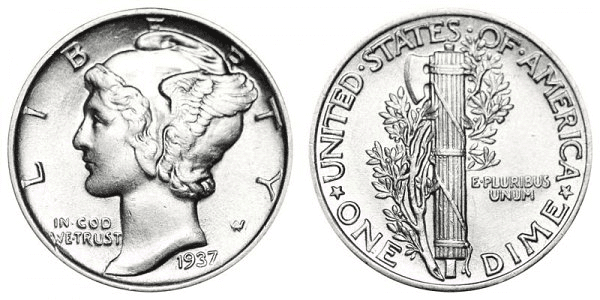
Albeit simple, the design of the dime is quite symbolic. Weinman’s ten-cent obverse (heads) depicts a young Liberty facing left with a wreath of tight curls and wearing a traditional but winged pileus, or Liberty cap. The winged cap symbolizes “liberty of thought.”
You can also see the following inscriptions on the obverse:
- LIBERTY
- IN GOD WE TRUST
- 1937
On the other hand, the reverse (tails) depicts a bundle of rods with a battle-axe, known as a “Fasces,” which symbolizes the unity or strength of the nation. It is contrasted with a large olive branch that represents peace. The inscriptions also include the following:
- UNITED STATES OF AMERICA
- E PLURIBUS UNUM
- ONE DIME
For a bit of curiosity, it’s interesting that Weinman’s never disclosed the model’s name for the obverse. Still, many were intrigued that he sculpted Elsie Stevens, the wife of the modernist poet and lawyer Wallace Stevens.
Although the dime’s design was overall favorable, the coin didn’t work well with vending machines. This is why it was replaced with a new design featuring President Franklin Roosevelt in 1946.
1937 Mercury Dime Varieties
The 1937 Mercury ten cents were minted at the three U.S. mints: Denver, Philadelphia, and San Francisco. In addition, the mints produced these coin varieties: 1937-D, 1937-P, and 1937-S. Overall, the combined number of coins released for circulation reached 80.7 million.
Here’s a list of 1938 Lincoln penny varieties and their mintage figure:
| Variety | Mint Location | Mintage |
| 1937 D Lincoln Wheat Penny | Denver | 14,146,000 |
| 1937 S Lincoln Wheat Penny | San Francisco | 9,740,000 |
| 1937 P Lincoln Wheat Penny | Philadelphia | 56,860,000 |
| 37 Proof Lincoln Wheat Penny | Philadelphia | 5,756 |
| Total | 80,751,756 |
Aside from these dime varieties, some coins were minted with errors for the 1937 Mercury dime series. Let’s see the descriptions of each type below:
1937 D Mercury Dime
Year of minting: 1937
Mint Mark: D
Place of minting: Denver
Quantity produced: 14,146,000
Face Value: $0.10 (10 cents)
Price: $2.25 to $4 (circulated condition)
Mass: 2.50 grams
Edge: Reeded
Designer: Adolph Weinman
Composition: 90% silver and 10% copper
Diameter: 17.91 millimeters
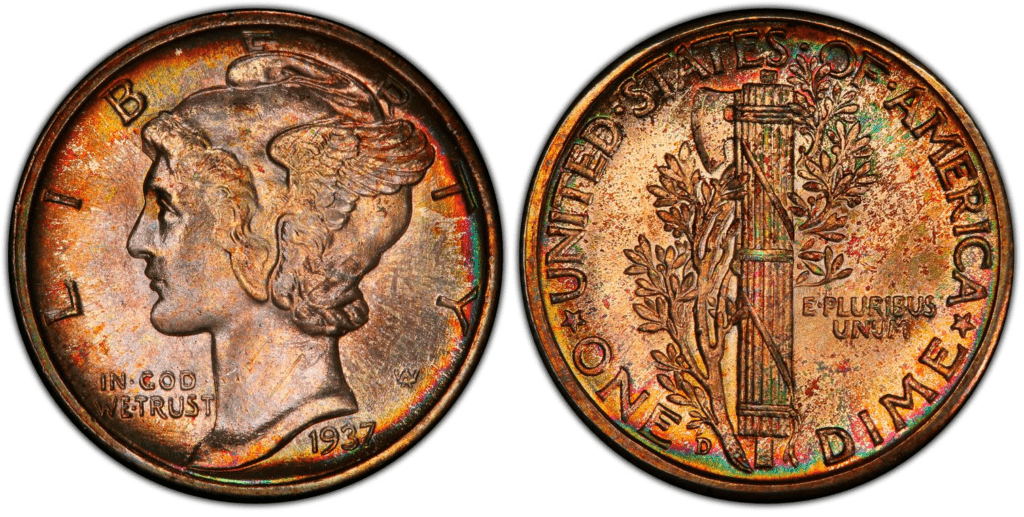
Denver struck over 14 million of 1937 Mercury dimes, the second highest of the three mints. The quality of all coins minted in Denver has improved since 1937. You can still find large samples of splendid gems for the 1937-D with Full Bands. Though it has repunched mintmark issues, it remained attractive to coin collectors.
1937 P Mercury Dime
Year of minting: 1937
Mint Mark: No mint mark
Place of minting: Philadelphia
Quantity produced: 56,860,000
Face Value: $0.10 (10 cents)
Price: $2.25 to $3.25 (circulated condition)
Mass: 2.50 grams
Edge: Reeded
Designer: Adolph Weinman
Composition: 90% silver and 10% copper
Diameter: 17.91 millimeters
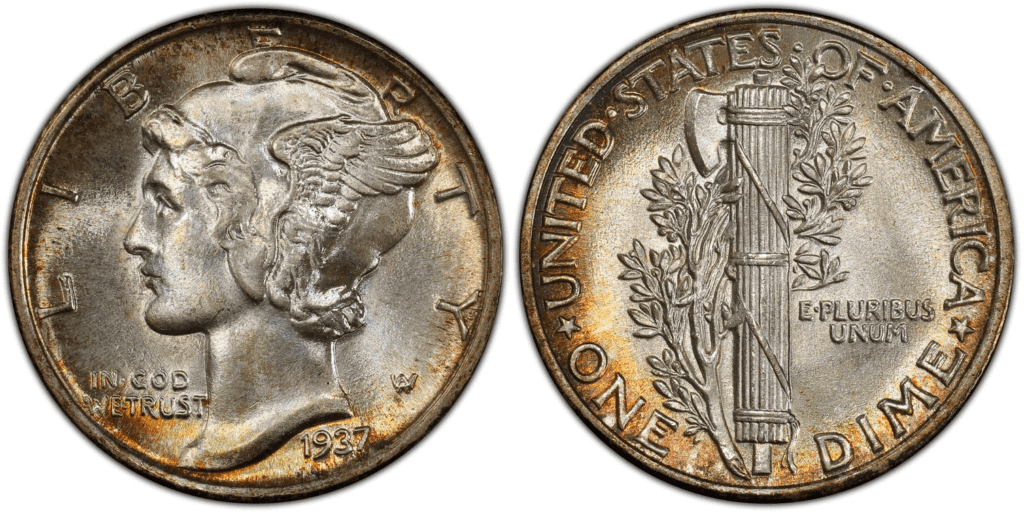
The mint in Philadelphia struck the most 1937 Mercury Dimes, at about 57 million. It is widespread, as you can still find Gem Uncirculated grades. There are also available MS67 samples in excellent detail with Full Bands. Most MS grades exhibit nice color.
1937 S Mercury Dime
Year of minting: 1937
Mint Mark: S
Place of minting: San Francisco
Quantity produced: 9,740,000
Face Value: $0.10 (10 cents)
Price: $2.25 to $3.50 (circulated condition)
Mass: 2.50 grams
Edge: Reeded
Designer: Adolph Weinman
Composition: 90% silver and 10% copper
Diameter: 17.91 millimeters
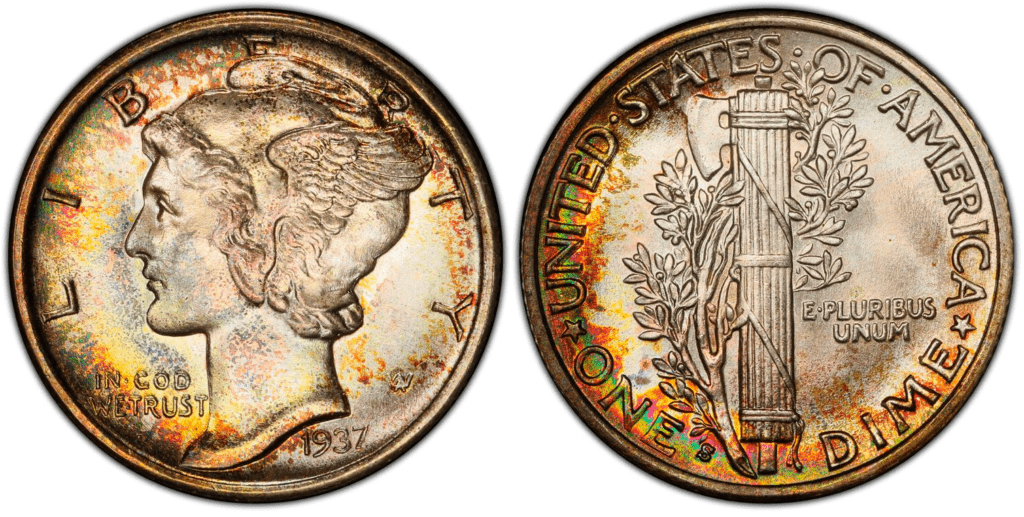
The San Francisco mint produced the fewest 1937 Mercury Dimes under 10 million for circulation. It is extremely common in all worn grades through Gem Uncirculated conditions. Many 1937-S are well-struck and exhibit Full Band details. Compared to 1937-P and 1937-D, finding MS67 or higher 1937-S dimes is a little tricky.
List Of 1937 Mercury Dime Errors
Producing many coins could cause the equipment to deteriorate or malfunction over time. Aside from that, there are also unavoidable human errors that can interfere with the minting process. Hence, these factors could lead to the production of error coins, and the 1937 Mercury Dime is no exception to that mint error.
Authentic error coins are different from damaged or worn-out coins. So, distinct types of errors occur depending on what causes the error. Some common types are clipped planchet, broadstrike, lamination flaw, doubled die, and many more.
Take a look at a sample of the 1937 Mercury Dime with doubled die error:
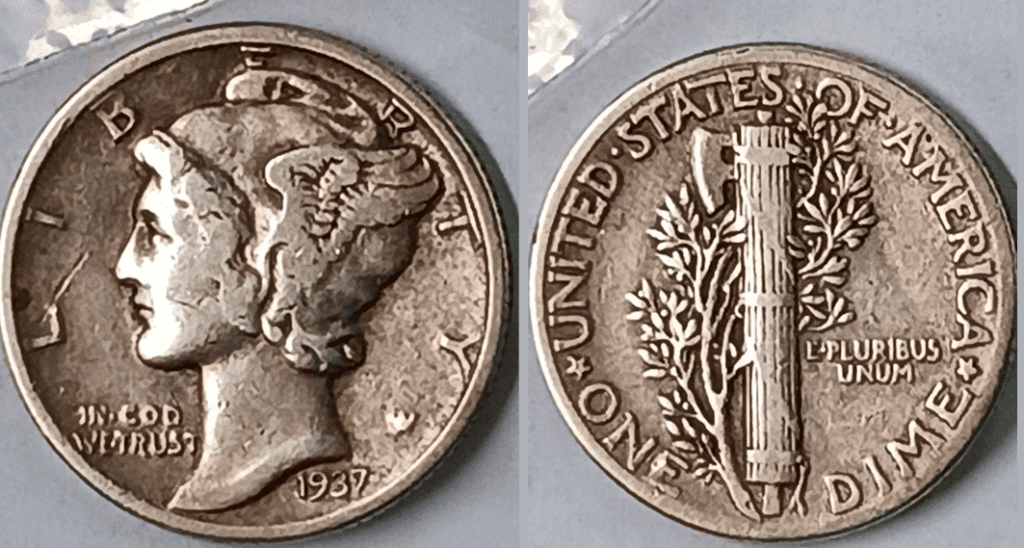
The doubled die error happens when there is a duplication of design elements on a working die. This occurs especially when the die or hub is misaligned during the hubbing process.
How Much Is The 1937 Mercury Dime Worth Today?
The 1937 Mercury Dime value is at a minimum of $2.25. Uncirculated conditions are being sold at approximately $12. However, if you want to get the actual value of your 1937 mercury Dime collection, you need to have it graded by a professional coin grader.
On the other hand, if you want to know the dime’s melting value, you should first see the value of its silver and copper content. Today, the melting value of the 1937 Mercury Dime is approximately $1.7544.
Now, if you’re basing your decision on the face value or melt value of the 1937 Mercury dime, you might be missing many earning opportunities. The reason is that the true value of the dime is found in its numismatic value.
Take a look at this chart of auction records for each variety of the 1937 Mercury Dime and get more idea of how valuable it can become:
| Coin | Condition | Grade | Sold date | Sold by | Value |
| 1937 Proof Lincoln Penny | Superb Gem Uncirculated | PR 68+ | March 31, 2021 | Stack’s Bowers | $26,400
|
| 1937 S Lincoln Penny | Superb Gem Uncirculated | MS 68 | August 11, 2010 | Heritage Auctions | $21,850 |
| 1937 D Lincoln Penny | Superb Gem Uncirculated | MS 68 | August 6, 2000 | Heritage Auctions | $16,100 |
| 1937 P Lincoln Penny | Superb Gem Uncirculated | MS 68 | August 6, 2000 | Heritage Auctions | $5,175 |
How Does The Grading System Work?
The wear or lack of it determines the actual value of a 1937 Mercury Dime. That is why, if you like to offer it at a reasonable price in the market, be sure to have it graded first to check the condition of your coin and its overall grade.
To assess the grade of a coin, professionals like numismatists use a 70-point scale tool like the Sheldon Scale. The scale uses these grading systems:
- PR system – used for Proof coins
- MS system – used for Circulated and Uncirculated coins
Meanwhile, the condition of the coin is also indicated. Poor (P – 1) indicates the worst condition, where the coin is unidentifiable or has as much damage. Perfect (MS – 70) means the Uncirculated coin is perfect in all its appearance, exhibiting a lustrous condition and flawless planchet when magnified 8x under the microscopic scale.
Some other common condition indicators that numismatists use are:
- Fair (FR – 2)
- Good (G – 4)
- Very Good (VG – 8)
- Fine (F – 12)
- Very Fine (VF – 20)
- Extremely Fine (EF – 40)
- Uncirculated (AU – 50)
- Choice Uncirculated (AU – 58)
- Uncirculated – Mint State Basal (MS – 60)
Where To Buy Or Sell 1937 Mercury Dime?
The internet is the most convenient and popular way to buy and sell your 1937 Mercury Dime. Online stores like Amazon, Etsy, or eBay are popular with many buyers and sellers. So if you like the convenience of online, register to any of these sites to offer your coins in the market.
In-person selling and buying is also a good option, like visiting a coin and auction house, pawn shops, or antique stores. This way, you can see the actual coin you’re buying.
Also, contacting experts from PCGS and NGC for consultation is worth a try, especially if you need more information about graded 1937 Mercury Dime collections.
FAQs
How much silver is in a 1937 Mercury dime?
The amount of silver used to produce the 1937 Mercury Dime is 90 percent. The other 10 percent of its composition is copper.
Where is the mint mark on a 1937 Mercury dime?
Dimes minted in Denver and San Francisco have mint marks. The 1937 coins from Denver have “D” marks, while those from San Francisco have “S” marks. You can find these mint marks on the reverse side below the olive branch near the “E” of ONE.
